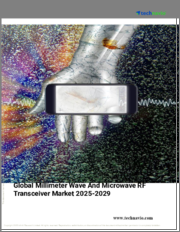
|
시장보고서
상품코드
1677872
자동차용 FlexRay 트랜시버 시장 규모, 점유율, 성장 분석 : 유형별, 용도별, 차종별, 지역별 - 산업 예측(2025-2032년)Automotive FlexRay Transceivers Market Size, Share, and Growth Analysis, By Type (Node Transceiver, Active Star Coupler), By Application (Powertrain & Vehicle Dynamics, Vehicle Networking), By Vehicle Type, By Region - Industry Forecast 2025-2032 |
||||||
세계의 자동차용 FlexRay 트랜시버 시장 규모는 2023년에 1억 3,607만 달러에 달하며, 2024년 1억 4,437만 달러에서 2032년에는 2억 3,185만 달러로 확대하며, 예측 기간(2025-2032년)의 CAGR은 6.1%로 성장할 전망입니다.
2023년 10월 현재, 차량용 FlexRay 트랜시버 시장은 첨단 통신 시스템을 필요로 하는 전기자동차와 하이브리드차 수요 증가로 인해 큰 성장이 예상되는데, 이는 FlexRay 트랜시버가 최적의 ECU 통신을 촉진하고 차량 성능을 향상시킬 수 있기 때문입니다. 높은 도입 비용과 기술의 복잡성 등 시장에는 과제도 존재하지만, 많은 업체들의 치열한 경쟁으로 인해 상황은 진화하고 있습니다. 주요 성장 동향으로는 첨단운전자보조시스템(ADAS)의 채택, 커넥티드카 기술의 급증, 자율주행차로의 진화 등을 들 수 있습니다. 구현의 간소화와 비용 절감을 가능하게 하는 통신 프로토콜의 표준화가 추진되고 있으며, 시장을 더욱 활성화시킬 수 있는 기회가 넘쳐나고 있습니다.
목차
서론
- 조사의 목적
- 조사 범위
- 정의
조사 방법
- 정보 조달
- 2차와 1차 데이터 방법
- 시장 규모 예측
- 시장의 전제조건과 제한
개요
- 세계 시장 전망
- 공급과 수요 동향 분석
- 부문별 기회 분석
시장 역학과 전망
- 시장 개요
- 시장 규모
- 시장 역학
- 촉진요인과 기회
- 억제요인과 과제
- Porter의 산업 분석
주요 시장 인사이트
- 주요 성공 요인
- 경쟁의 정도
- 주요 투자 기회
- 시장 에코시스템
- 시장의 매력 지수(2024년)
- PESTEL 분석
- 거시경제 지표
- 밸류체인 분석
- 가격 분석
- 사례 연구
- 규제 상황
자동차용 FlexRay 트랜시버 시장 규모 : 유형별 & CAGR(2025-2032)
- 시장 개요
- 노드 트랜시버
- 액티브 스타 커플러
- 기타
자동차용 FlexRay 트랜시버 시장 규모 : 용도별 & CAGR(2025-2032)
- 시장 개요
- 파워트레인과 차량 역학
- 차량 네트워크
- 기타
자동차용 FlexRay 트랜시버 시장 규모 : 차종별 & CAGR(2025-2032)
- 시장 개요
- 승용차
- 소형 상용차(LCV)
- 대형 상용차(HCV)
자동차용 FlexRay 트랜시버 시장 규모 : 지역별 & CAGR(2025-2032)
- 북미
- 미국
- 캐나다
- 유럽
- 독일
- 스페인
- 프랑스
- 영국
- 이탈리아
- 기타 유럽 지역
- 아시아태평양
- 중국
- 인도
- 일본
- 한국
- 기타 아시아태평양
- 라틴아메리카
- 브라질
- 기타 라틴아메리카 지역
- 중동 및 아프리카
- GCC 국가
- 남아프리카공화국
- 기타 중동 및 아프리카
경쟁 정보
- 상위 5사의 비교
- 주요 기업의 시장 포지셔닝(2024년)
- 주요 시장 기업이 채택한 전략
- 최근 시장 동향
- 기업의 시장 점유율 분석(2024년)
- 주요 기업의 기업 개요
- 기업의 상세
- 제품 포트폴리오 분석
- 기업의 부문별 점유율 분석
- 매출의 전년대비 비교(2022-2024)
주요 기업 개요
- Infineon Technologies(Germany)
- Texas Instruments(USA)
- STMicroelectronics(Switzerland)
- Analog Devices(USA)
- ON Semiconductor(USA)
- Renesas Electronics Corporation(Japan)
- Broadcom Inc.(USA)
- Melexis(Belgium)
- Microchip Technology(USA)
- Robert Bosch GmbH(Germany)
- Marvell Technology Group(USA)
- Integrated Device Technology(USA)
- Silicon Laboratories(USA)
- ROHM Semiconductor(Japan)
- Continental AG(Germany)
- Vector Informatik GmbH(Germany)
결론과 제안
KSA 25.04.18Global Automotive FlexRay Transceivers Market size was valued at USD 136.07 million in 2023 and is poised to grow from USD 144.37 million in 2024 to USD 231.85 million by 2032, growing at a CAGR of 6.1% during the forecast period (2025-2032).
As of October 2023, the Automotive FlexRay Transceivers Market is poised for significant growth, spurred by the rising demand for electric and hybrid vehicles, which necessitate advanced communication systems. This trend is primarily driven by consumers' desire for enhanced fuel efficiency and lower emissions, as FlexRay transceivers facilitate optimal ECU communication, resulting in improved vehicle performance. Although market challenges exist, including high implementation costs and technological complexity, the landscape is evolving with strong competition among numerous players. Key growth trends include the adoption of advanced driver assistance systems (ADAS), the surge in connected car technology, and the advancement toward autonomous vehicles. Opportunities abound with a push for standardizing communication protocols that can streamline implementation and reduce costs, further energizing the market.
Top-down and bottom-up approaches were used to estimate and validate the size of the Global Automotive Flexray Transceivers market and to estimate the size of various other dependent submarkets. The research methodology used to estimate the market size includes the following details: The key players in the market were identified through secondary research, and their market shares in the respective regions were determined through primary and secondary research. This entire procedure includes the study of the annual and financial reports of the top market players and extensive interviews for key insights from industry leaders such as CEOs, VPs, directors, and marketing executives. All percentage shares split, and breakdowns were determined using secondary sources and verified through Primary sources. All possible parameters that affect the markets covered in this research study have been accounted for, viewed in extensive detail, verified through primary research, and analyzed to get the final quantitative and qualitative data.
Global Automotive Flexray Transceivers Market Segments Analysis
Global Automotive FlexRay Transceivers Market is segmented by Type, Application, Vehicle Type and region. Based on Type, the market is segmented into Node Transceiver, Active Star Coupler and Others. Based on Application, the market is segmented into Powertrain & Vehicle Dynamics, Vehicle Networking and Others. Based on Vehicle Type, the market is segmented into Passenger Cars, Light Commercial Vehicles (LCVs) and Heavy Commercial Vehicles (HCVs). Based on region, the market is segmented into North America, Europe, Asia Pacific, Latin America and Middle East & Africa.
Driver of the Global Automotive Flexray Transceivers Market
The increasing adoption of Advanced Driver Assistance Systems (ADAS), including features like lane departure warning, adaptive cruise control, and blind-spot detection, necessitates rapid and reliable communication among a vehicle's electronic components. FlexRay technology emerges as a crucial solution, offering the high-speed data transfer needed for these safety-sensitive applications. Consequently, the growing reliance on FlexRay for effective communication in ADAS is significantly propelling the demand for FlexRay transceivers in the global market. This trend highlights the essential role that advanced communication technologies play in enhancing vehicle safety and overall performance, fueling further market growth.
Restraints in the Global Automotive Flexray Transceivers Market
The global market for automotive FlexRay transceivers faces a significant constraint due to the substantial investment needed for hardware, software, and system integration associated with FlexRay technology. The high costs involved in implementing this advanced communication protocol act as a barrier to widespread adoption within the automotive sector. Many manufacturers may be hesitant to commit to such an expensive undertaking, preferring to rely on more established technologies that offer lower entry costs. As a result, this financial challenge poses a notable limitation to the growth and acceptance of FlexRay solutions in the automotive industry.
Market Trends of the Global Automotive Flexray Transceivers Market
The Global Automotive FlexRay Transceivers market is currently witnessing a significant trend toward the integration of FlexRay technology with Ethernet-based communication protocols, aimed at enhancing in-vehicle networking efficiency. As the automotive sector increasingly embraces advanced functionalities such as autonomous driving and connected vehicles, the need for robust communication solutions becomes paramount. This hybrid approach not only improves data transfer rates and reduces latency but also ensures compatibility with modern automotive architectures. Consequently, manufacturers are focusing on developing innovative FlexRay transceivers that support Ethernet integration, positioning themselves competitively in the evolving automotive market landscape. This shift is anticipated to drive substantial growth in the FlexRay transceivers segment, catering to the demands of innovative automotive applications.
Table of Contents
Introduction
- Objectives of the Study
- Scope of the Report
- Definitions
Research Methodology
- Information Procurement
- Secondary & Primary Data Methods
- Market Size Estimation
- Market Assumptions & Limitations
Executive Summary
- Global Market Outlook
- Supply & Demand Trend Analysis
- Segmental Opportunity Analysis
Market Dynamics & Outlook
- Market Overview
- Market Size
- Market Dynamics
- Drivers & Opportunities
- Restraints & Challenges
- Porters Analysis
- Competitive rivalry
- Threat of substitute
- Bargaining power of buyers
- Threat of new entrants
- Bargaining power of suppliers
Key Market Insights
- Key Success Factors
- Degree of Competition
- Top Investment Pockets
- Market Ecosystem
- Market Attractiveness Index, 2024
- PESTEL Analysis
- Macro-Economic Indicators
- Value Chain Analysis
- Pricing Analysis
- Case Studies
- Regulatory Landscape
Global Automotive FlexRay Transceivers Market Size by Type & CAGR (2025-2032)
- Market Overview
- Node Transceiver
- Active Star Coupler
- Others
Global Automotive FlexRay Transceivers Market Size by Application & CAGR (2025-2032)
- Market Overview
- Powertrain & Vehicle Dynamics
- Vehicle Networking
- Others
Global Automotive FlexRay Transceivers Market Size by Vehicle Type & CAGR (2025-2032)
- Market Overview
- Passenger Cars
- Light Commercial Vehicles (LCVs)
- Heavy Commercial Vehicles (HCVs)
Global Automotive FlexRay Transceivers Market Size & CAGR (2025-2032)
- North America (Type, Application, Vehicle Type)
- US
- Canada
- Europe (Type, Application, Vehicle Type)
- Germany
- Spain
- France
- UK
- Italy
- Rest of Europe
- Asia Pacific (Type, Application, Vehicle Type)
- China
- India
- Japan
- South Korea
- Rest of Asia-Pacific
- Latin America (Type, Application, Vehicle Type)
- Brazil
- Rest of Latin America
- Middle East & Africa (Type, Application, Vehicle Type)
- GCC Countries
- South Africa
- Rest of Middle East & Africa
Competitive Intelligence
- Top 5 Player Comparison
- Market Positioning of Key Players, 2024
- Strategies Adopted by Key Market Players
- Recent Developments in the Market
- Company Market Share Analysis, 2024
- Company Profiles of All Key Players
- Company Details
- Product Portfolio Analysis
- Company's Segmental Share Analysis
- Revenue Y-O-Y Comparison (2022-2024)
Key Company Profiles
- Infineon Technologies (Germany)
- Company Overview
- Business Segment Overview
- Financial Updates
- Key Developments
- Texas Instruments (USA)
- Company Overview
- Business Segment Overview
- Financial Updates
- Key Developments
- STMicroelectronics (Switzerland)
- Company Overview
- Business Segment Overview
- Financial Updates
- Key Developments
- Analog Devices (USA)
- Company Overview
- Business Segment Overview
- Financial Updates
- Key Developments
- ON Semiconductor (USA)
- Company Overview
- Business Segment Overview
- Financial Updates
- Key Developments
- Renesas Electronics Corporation (Japan)
- Company Overview
- Business Segment Overview
- Financial Updates
- Key Developments
- Broadcom Inc. (USA)
- Company Overview
- Business Segment Overview
- Financial Updates
- Key Developments
- Melexis (Belgium)
- Company Overview
- Business Segment Overview
- Financial Updates
- Key Developments
- Microchip Technology (USA)
- Company Overview
- Business Segment Overview
- Financial Updates
- Key Developments
- Robert Bosch GmbH (Germany)
- Company Overview
- Business Segment Overview
- Financial Updates
- Key Developments
- Marvell Technology Group (USA)
- Company Overview
- Business Segment Overview
- Financial Updates
- Key Developments
- Integrated Device Technology (USA)
- Company Overview
- Business Segment Overview
- Financial Updates
- Key Developments
- Silicon Laboratories (USA)
- Company Overview
- Business Segment Overview
- Financial Updates
- Key Developments
- ROHM Semiconductor (Japan)
- Company Overview
- Business Segment Overview
- Financial Updates
- Key Developments
- Continental AG (Germany)
- Company Overview
- Business Segment Overview
- Financial Updates
- Key Developments
- Vector Informatik GmbH (Germany)
- Company Overview
- Business Segment Overview
- Financial Updates
- Key Developments



















